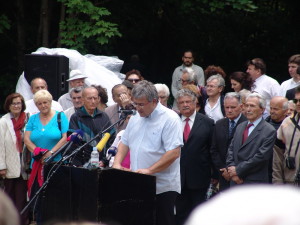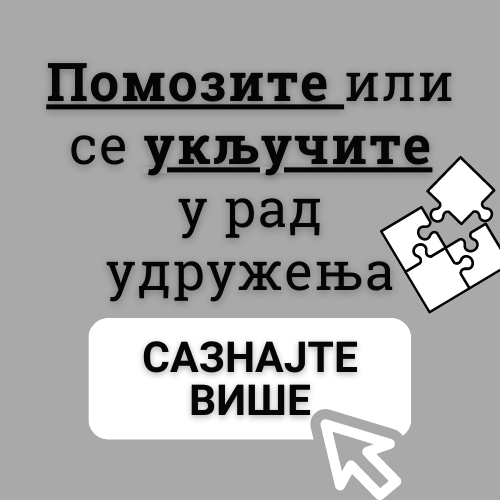The President of the Republic of Croatia, Your Excellencies, Ladies and Gentlemen, Good day to you all.
Your Grace, the Bishop, brothers and sisters, May God Help Us!
I greet you on behalf of the Association of descendants and others honoring the victims of the 1941 Ustasha concentration camp complex known as Jadovno.
I am deeply grateful to all those who have supported our initiative to mark the first Remembrance Day for Jadovno today, in such a dignified way and with the restoration of these two commemorative plaques.
Among the many good people helping us, I would especially mention the support of the Serbian National Council, the Association of Serbs from Croatia refugee societies in Belgrade, the Gornjo-Karlovačka Diocese of the Serbian Orthodox church and Serb organizations from Central Europe.
The great understanding of the deputy-prefect of Lika-Senj county, Mr. Milan Krmpotić, means a lot to us and awakens the hope that we can expect more in terms of dignified care and maintenance of the legally registered Jadovno Memorial area and the Šaranova jama Memorial area, and the Slana Memorial area at the former concentration camp site on the island of Pag.
I know that it is not appropriate to deliver long speeches in such a sad and sacred place…
For descendants of the victims and for all the people honoring them, this is primarily a place of serenity, remembrance, forgiveness and prayer. At the same time, for the descendants of those who committed crimes here in 1941, and for those who destroyed the memorials and monuments here in 1971 as well as in 1991, thus killing the victims again, this must be a place of shame, repentance and prayers for the salvation of their own souls.
Jadovno itself, as its ill-portending name suggests, stands for great sorrow, great grief, great sadness.
This death camp complex was painstakingly planned to eliminate the unwanted citizens of Pavelic’s Independent State of Croatia. The place itself was carefully chosen even before the war began. Velebit, a mountain full of bottomless karst caves, the sea depths of Pag and of Velebit channel, the stoney desert of Slan with a bit of earth at Furnaža, these were ideal sites for Ustasha planners to commit massive and rapid slaughter. They knew that these execution places, remote from the public eye, would be hard to find and even harder to investigate.
Only a depraved mind could have been able to put a picture of the area around this Jadovno death camp on what was a 1000-kuna banknote.
A good railway network allowed for the transport of undesirables from the entire territory of the Independent State of Croatia in cattle cars often labeled „rotten fruit,“ for delivery quickly to Gospić.
Waiting for them there were concentration camps right at the railway station and at the so-called Ovčara (Sheep ranch). From those places, groups were moved out under guard toward the county penitentiary at Gospic, toward Velebit mountain, toward Stupacinovo concentration camp or toward the island of Pag. Many did not even arrive at those destinations as they were thrown down into pits along the way, had their stomachs cut open (so as to prevent them from ever being able to climb back to the surface), or had stones tied around their necks before being hurled into the sea.
Others were marched out in double columns with their hands chained together so that the first few rows could be executed by hand and then be pushed into the crevasses so their weight pulled down all the rows of people tied behind their corpses. Such victims „did not deserve even a bullet, which was expensive, but instead a punishing method of liquidation“ as the perpetrators admitted to postwar crime investigators.
Jadovno is a place whose name from 1941 till today has been painfully etched into the consciousness of the victims’ descendants. This killing site, as the last stop on their path to martyrdom, is mentioned with sadness and tears as a place where lives were extinguished in the most horrible ways, and where our lives, the lives of their relatives and descendants, were altered forever.
Awareness that they, having been totally innocent, after enduring such a terrible trip, and after being attacked with a mallet or a knife, some still alive, were plunged down into a deep pit or thrown into the sea with a stone around the neck, left a wound in our souls that can never be healed and which is therefore passed from one generation onto the next.
Just a few times did some family members come here over the open pit of Šaran – to drop flowers down into the abyss and to light candles in a prayer for the victims to rest in peace.
For many who tried to visit this place where their loved ones were killed, it was hard even to find a path to this Memorial site because after you pass the the Village of Jadovno there is not even a signpost even today, and the locals purposely avoid any contact with us at all.
From the very establishment of the Independent State of Croatia, its Ustasha rulers and their armed groups sought to conceal the evil, the killings, the mass bloodshed and the massacres of the civilian population. Upon the elimination of the Jadovno camp in late August 1941, the perpetrators threw down into some of the pits large piles of tree branches and stones to cover the bodies of their murder victims, and at some of pits they closed up the entry with concrete. Many such killing sites remain hidden under a veil of secrecy to this very day.
And the perpetrators were not alone in erasing their traces. The resident population near these mass graves also contributed to keeping the truth unknown by hiding these locations from anyone who showed any interest, and over the course of inevitable natural processes, were aided in their task by dense new vegetation overgrowing and covering up any trace at all of many of the sites.
All during the war, the truth about the atrocities was manipulated in false documents, the crimes were hidden and minimized, and clues were completely erased. The Ustasha destroyed many other pieces of evidence as the war progressed.
In the post-war period (1945-1990) any public mention of the victims of Ustasha terror was greatly restricted both in physical human scale and in terms of its consequences.
Not only were certain individuals destroying any surviving written documents, but so too were authorities of liberated Yugoslavia preventing the collection or publication of authentic data about the Ustasha massacres of the Serbian and Jewish people. They did whatever they could to ensure that this subject was spoken of and written about as little as possible.
In general, it was seen as undesirable and counterproductive to the building of „brotherhood and unity“ to even mention the Serbian and Jewish victims. It is well known that even some of the first to take up arms (prvoborci) opposed to this „silence“ were themselves quickly punished.
Professor Ante Zemljar, who was himself from Pag Island, was the author of the one and only book about the Slana and Metajna camps, and after in 1947 and 1948 leading inhabitants of Pag to the area of the Slana camp to lay wreaths, ended up imprisoned on the Goli Otok (Naked Island) re-education camp.
Branko Cetina, one of the few people who managed to escape from the Jadovno camp, was immediately forced to retire after he gave a history class to families of Jadovno victims, even though he was a Communist Partisan officer with the rank of colonel.
Until recent days, only Jasenovac, among all the Ustashe death camps, known by many as a major site of slaughter of Serbian people, was respectfully memorialized with an annual commemoration of the anniversary of the inmates’ breakout, an event that gathers the families of the killed and even gets some media attention.
Rarely the „Danica“, Sisak and Jastrebarsko camps are mentioned…
But as for the Jadovno Camp, barely a word was heard of it. It was as if there had been an imposed silence that had generated total „public amnesia.“ To date, even 69 years after the massacre of so many innocent people, these places remain unmarked, and no pity has been shown for these martyrs. This purposeful and controlled post-war silence and the accompanying eradication of the truth, took advantage of a lack of awareness among the victims’ own descendants – something that psychologists say has been very common ever since the war.
Inside the victims’ families, Jadovno was mentioned, but under that name, people generally implied this Šaran cave. It was still rare for any among them to know that near the pit there was a camp, and in any event, this location was unmarked and there was no road to get to this place.
The fact that right here there was once the entire Jadovno camp complex, was a fact virtually unknown not just to the public, but among our own families, and even today, only a very few people know anything about it.
The name of this execution site, the „1941 Jadovno complex of Ustasha camps” appeared in print for the first time only in 2007, as the title of the two-volume life’s work of Đure Zatezalo.
I have to say that without that capital work, finished in 1990 but never finding a publisher in Croatia, even today we would know almost nothing about Jadovno. Without Zatezalo’s full personal commitment to Jadovno history research and without his tremendous energy, our association, Jadovno 1941, would not even be here today.
The concealing of the truth about Jadovno, and the vilification and humiliation of the victims and their descendants continues to the present day. If you look around here, it all becomes completely clear…
If the truth of Jadovno were not still hidden, then the descendants of the victims would not have to wander aimlessly through this Velebit „nature resort“ with Dr. Zatezalo, searching for the site where Jadovno operated, nor would they have to burn under the sun in a rocky desert looking for the location of the smashed memorial plaque at Slana, nor would they need to walk holding a proverbial „lantern“ looking for anyone in Metajna willing to show them the way to the former concentration camp for women and children. If there were any respect for the victims, there would not be a bike-racing path between the Jadovno killing pits nor would the Slana Memorial area serve as a site for sunbathing, swimming and scuba diving.
I will not personally talk about the number of victims killed at the Jadovno Ustashe concentration camp in 1941 because I do not want to open the door to the abuse of this Jadovno Day of Remembrance by those who in their self-proclaimed „mathematical“ calculations compare our victims to sardines in cans.
But, if you look at the research by Đuro Zatetalo, Francis Zdunić Leo, Fikreta Jelic-Bunić or Slavko Goldstein, you will see that all of them talk about tens of thousands of victims. It is difficult even for us to conceptualize such numbers in our own minds.
However, we descendants of Jadovno victims, counting the broken branches of our family trees in our genealogy — only we can know and feel the pain of the irreparable loss represented by each life taken here at this site.
Until recently, there was no remembrance day for Jadovno. On the initiative of the descendants Association of Jadovno, June 24 has been designated as the „Jadovno 1941 Day of Remembrance.“ On that date in 1941, Slanat concentration camp on the island of Pag received its first detainees and Jadovno camp on Velebit mountain reached its full dimensions. So far, several institutions have recognized this date and put it into their calendars marking execution sites from World War II. I beg you, leaders of the institutions of the Republic of Croatia, do the same.
This day should be remembered and must remind us of the crime and the tragedy that occurred here – we must not forget, and must never let a similar fate ever befall anyone again.
I must say, some hinted to us that our Jadovno commemoration would best be held only on „round number“ anniversaries such as the 70th, 75th, and 80th, so that when the 85th arrived, even the grandchildren of most Jadovno victims would no longer be among the living. Of course such proposals come as no surprise — they are but a facet of the earlier-mentioned continuity.
No, we will come to Jadovno every year, and if God grants us, we will come here several times per year. Until the pits full of the remains of our family members have been replaced with graves…
Jadovno will stay in our souls, in our thoughts and in our prayers and all we do here represents merely dignified behavior toward the innocent victims, the members of our own families. And this is as well our responsibility to our descendants, it represents our commitment to a safe tomorrow and to the lesson never to forget Jadovno, so that it can never happen again.
Thank you.
A speech by Dušan Bastašić at Jadovno, on June 26, 2010.



